

Compact Muon Solenoid
LHC, CERN
| CMS-PAS-B2G-20-011 | ||
| Search for pair production of vector-like quarks in leptonic final states at √s= 13 TeV | ||
| CMS Collaboration | ||
| May 2022 | ||
| Abstract: A search is presented for vector-like T and B quark-antiquark pairs produced in proton-proton collisions at a center-of-mass energy of 13 TeV. Data were collected by the CMS Experiment in 2016, 2017, and 2018, with an integrated luminosity of 137 fb−1. Events with leptonic signatures are selected: one electron or muon, missing transverse energy, and at least three large-radius jets in the single-lepton channel; two electrons or muons with matching electric charge in the same-sign dilepton channel; and three or more electrons or muons in the multilepton channel. The single-lepton channel utilizes a multilayer neural network and jet identification techniques to discriminate signal events, while the same-sign dilepton and multilepton channels rely on the high-energy signature of the signal to distinguish it from rare standard model backgrounds. The production of vector-like quark pairs is excluded for T quark masses up to 1.54 TeV and B quark masses up to 1.56 TeV depending on the branching fractions assumed, with maximal sensitivity to decay modes that include multiple top quarks. These are the strongest limits to date for T¯T production with decays to tH and bW and B¯B production with decays to tW. | ||
| Links: CDS record (PDF) ; CADI line (restricted) ; | ||
| Figures | |
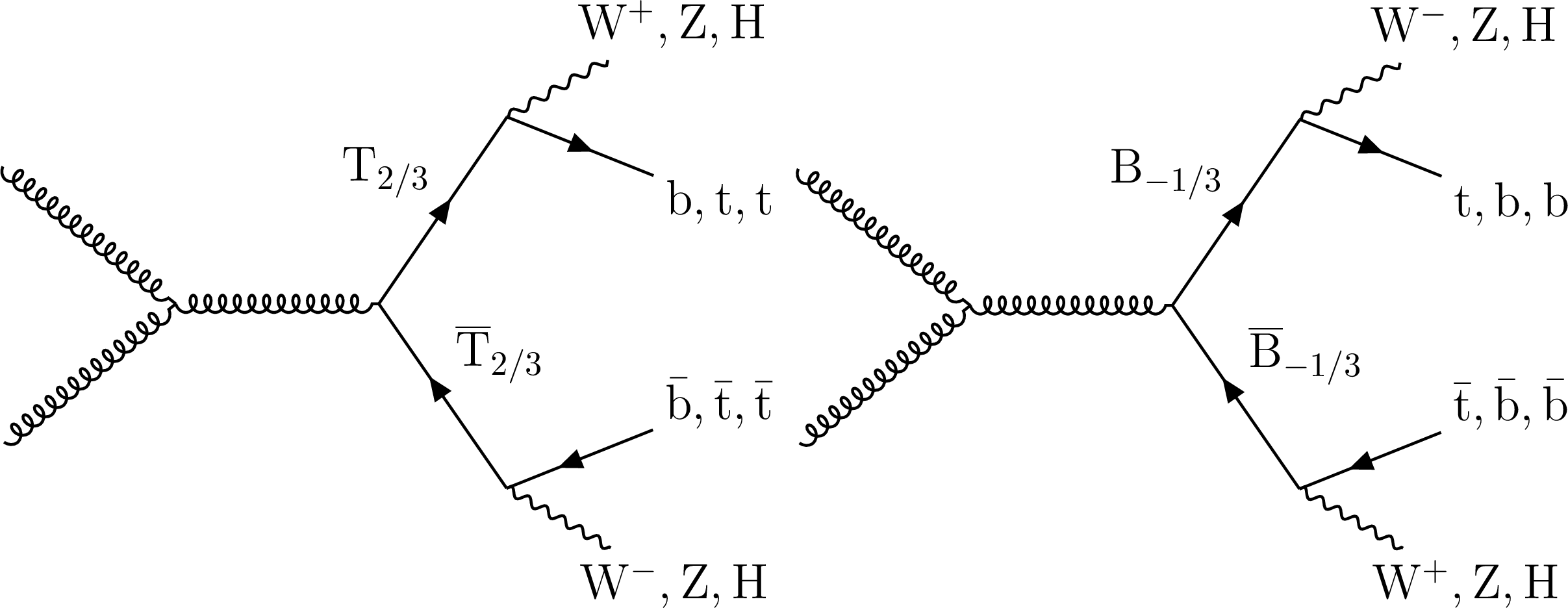
png pdf |
Figure 1:
Leading order Feynman diagrams showing pair production of T¯T (left) or B¯B (right) with representative decays to third generation quarks and SM bosons. |
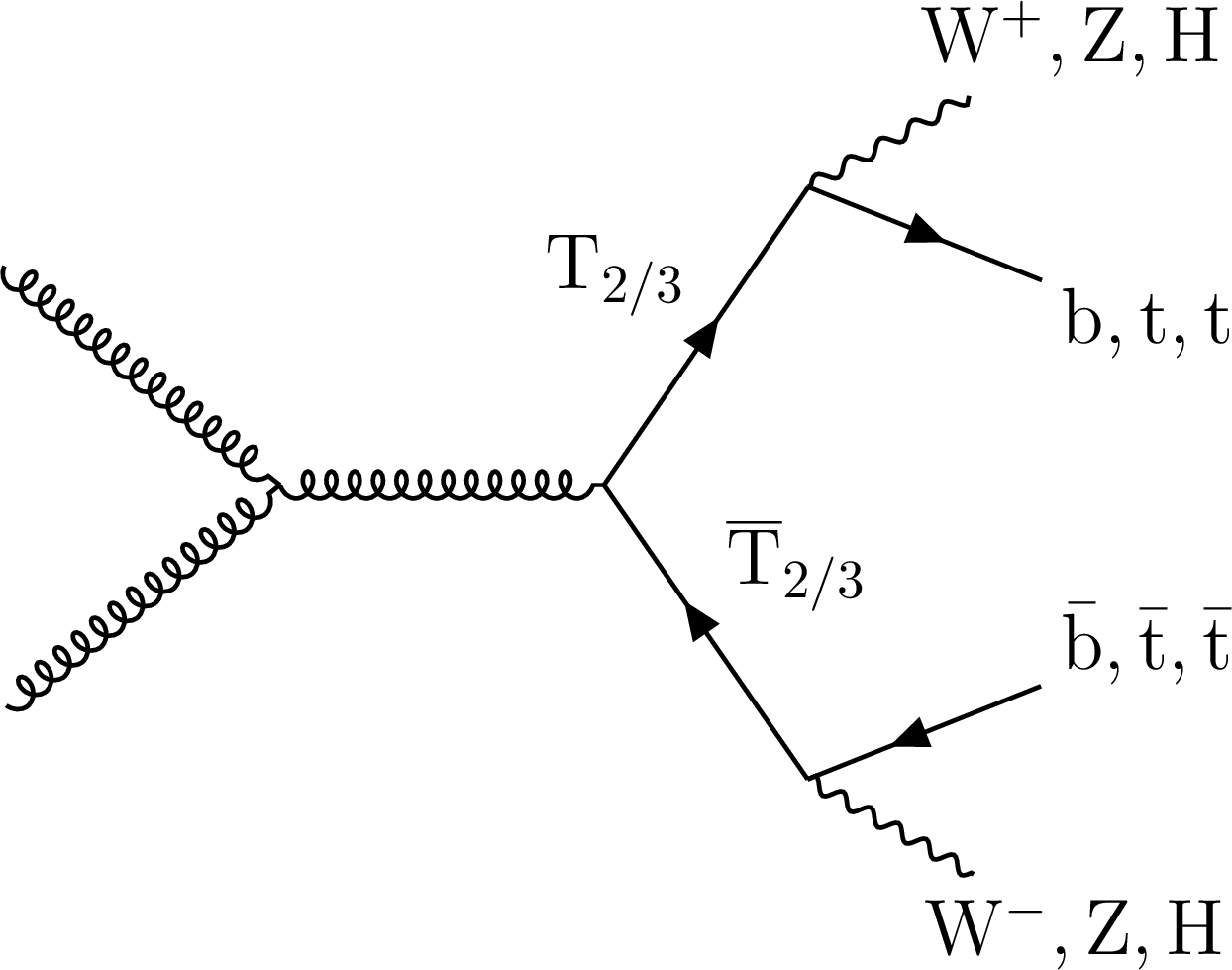
png pdf |
Figure 1-a:
Leading order Feynman diagrams showing pair production of T¯T (left) or B¯B (right) with representative decays to third generation quarks and SM bosons. |
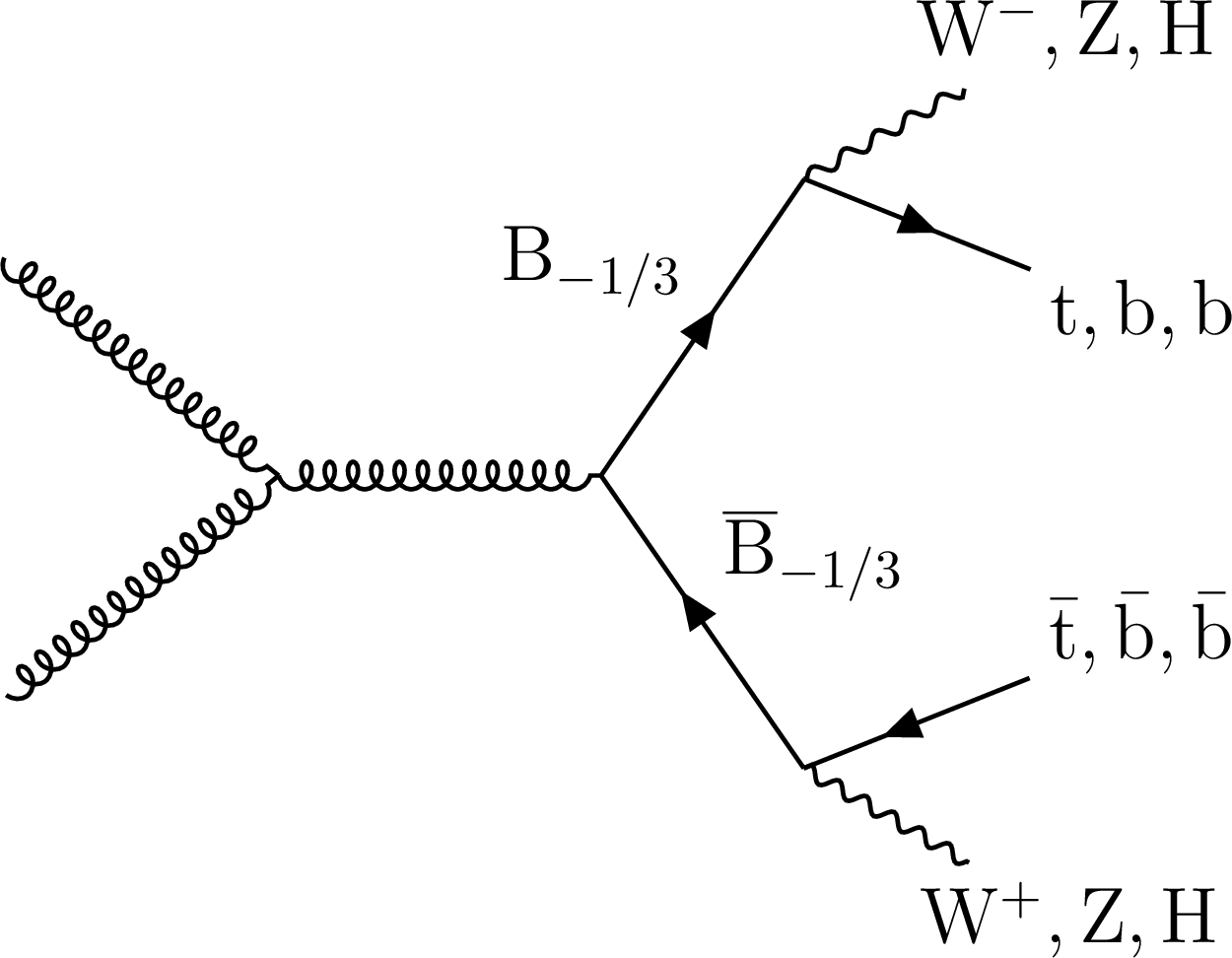
png pdf |
Figure 1-b:
Leading order Feynman diagrams showing pair production of T¯T (left) or B¯B (right) with representative decays to third generation quarks and SM bosons. |

png pdf |
Figure 2:
Distributions of DeepAK8 jet tags in the DeepAK8 CR (left), and HT in the W+jets (center) and tˉt (right) CRs of the T¯T search. The observed data are shown using black markers, T¯T signals using solid lines, and background using filled histograms. Statistical and systematic uncertainties in the background prediction before performing the fit to data are shown by the hatched region. |
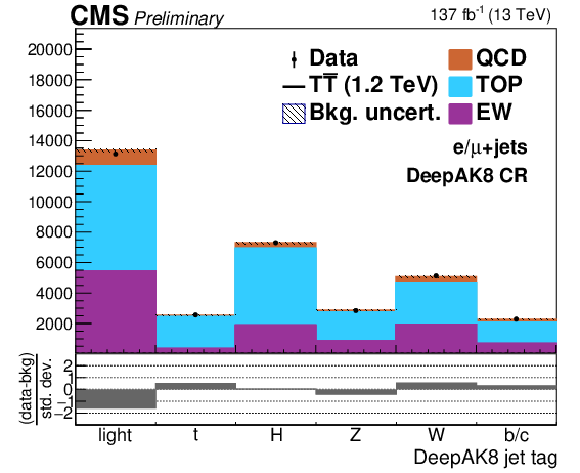
png pdf |
Figure 2-a:
Distributions of DeepAK8 jet tags in the DeepAK8 CR (left), and HT in the W+jets (center) and tˉt (right) CRs of the T¯T search. The observed data are shown using black markers, T¯T signals using solid lines, and background using filled histograms. Statistical and systematic uncertainties in the background prediction before performing the fit to data are shown by the hatched region. |

png pdf |
Figure 2-b:
Distributions of DeepAK8 jet tags in the DeepAK8 CR (left), and HT in the W+jets (center) and tˉt (right) CRs of the T¯T search. The observed data are shown using black markers, T¯T signals using solid lines, and background using filled histograms. Statistical and systematic uncertainties in the background prediction before performing the fit to data are shown by the hatched region. |
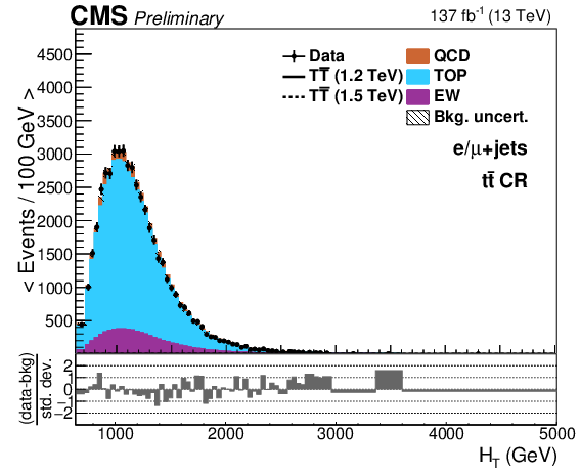
png pdf |
Figure 2-c:
Distributions of DeepAK8 jet tags in the DeepAK8 CR (left), and HT in the W+jets (center) and tˉt (right) CRs of the T¯T search. The observed data are shown using black markers, T¯T signals using solid lines, and background using filled histograms. Statistical and systematic uncertainties in the background prediction before performing the fit to data are shown by the hatched region. |

png pdf |
Figure 3:
Distribution of lepton pT in 2017 (left) and 2018 (right) in the multilepton channel nonprompt lepton control region for all flavor categories, evaluated with the best-fit nonprompt rates. The uncertainty shown is the quadratic sum of statistical and systematics uncertainties. |
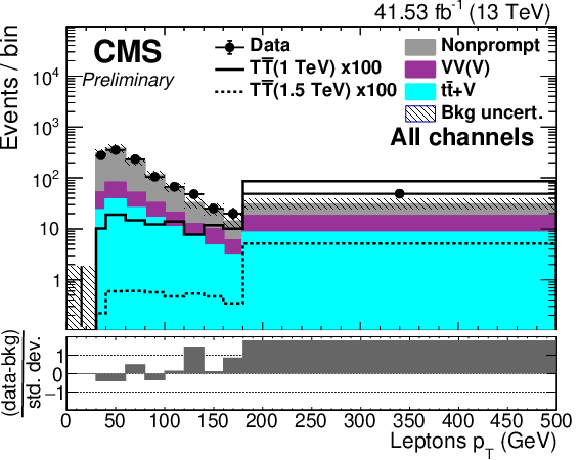
png pdf |
Figure 3-a:
Distribution of lepton pT in 2017 (left) and 2018 (right) in the multilepton channel nonprompt lepton control region for all flavor categories, evaluated with the best-fit nonprompt rates. The uncertainty shown is the quadratic sum of statistical and systematics uncertainties. |

png pdf |
Figure 3-b:
Distribution of lepton pT in 2017 (left) and 2018 (right) in the multilepton channel nonprompt lepton control region for all flavor categories, evaluated with the best-fit nonprompt rates. The uncertainty shown is the quadratic sum of statistical and systematics uncertainties. |
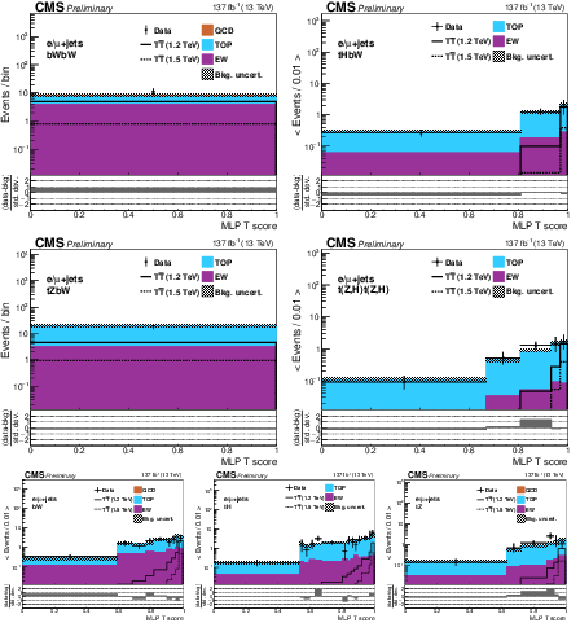
png pdf |
Figure 4:
Distributions of the VLQ score in single-lepton categories 1-7 (left-to-right, upper-to-lower). Observed data is shown using black markers, T¯T signal with mass of 1.2 (1.5) TeV in the singlet scenario using solid (dashed) lines, and post-fit background using filled histograms. Statistical and systematic uncertainties in the background prediction after performing the fit to data are shown by the hatched region. Electron and muon categories have been combined with their uncertainties added in quadrature. |

png pdf |
Figure 4-a:
Distributions of the VLQ score in single-lepton categories 1-7 (left-to-right, upper-to-lower). Observed data is shown using black markers, T¯T signal with mass of 1.2 (1.5) TeV in the singlet scenario using solid (dashed) lines, and post-fit background using filled histograms. Statistical and systematic uncertainties in the background prediction after performing the fit to data are shown by the hatched region. Electron and muon categories have been combined with their uncertainties added in quadrature. |
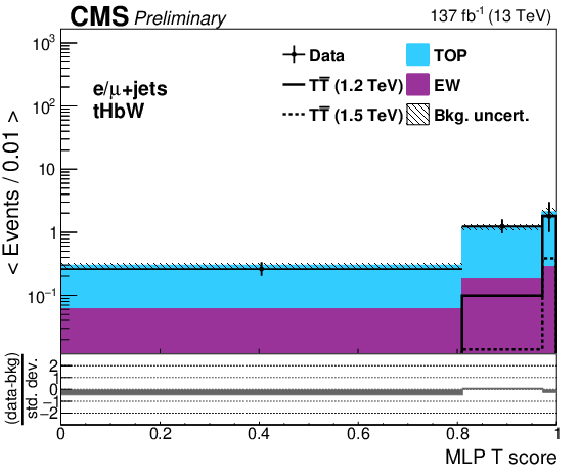
png pdf |
Figure 4-b:
Distributions of the VLQ score in single-lepton categories 1-7 (left-to-right, upper-to-lower). Observed data is shown using black markers, T¯T signal with mass of 1.2 (1.5) TeV in the singlet scenario using solid (dashed) lines, and post-fit background using filled histograms. Statistical and systematic uncertainties in the background prediction after performing the fit to data are shown by the hatched region. Electron and muon categories have been combined with their uncertainties added in quadrature. |
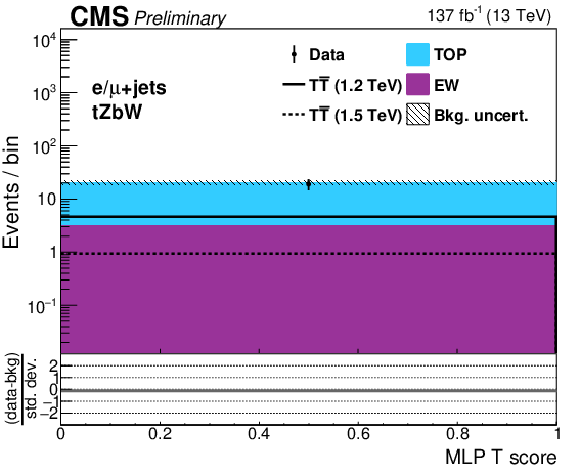
png pdf |
Figure 4-c:
Distributions of the VLQ score in single-lepton categories 1-7 (left-to-right, upper-to-lower). Observed data is shown using black markers, T¯T signal with mass of 1.2 (1.5) TeV in the singlet scenario using solid (dashed) lines, and post-fit background using filled histograms. Statistical and systematic uncertainties in the background prediction after performing the fit to data are shown by the hatched region. Electron and muon categories have been combined with their uncertainties added in quadrature. |
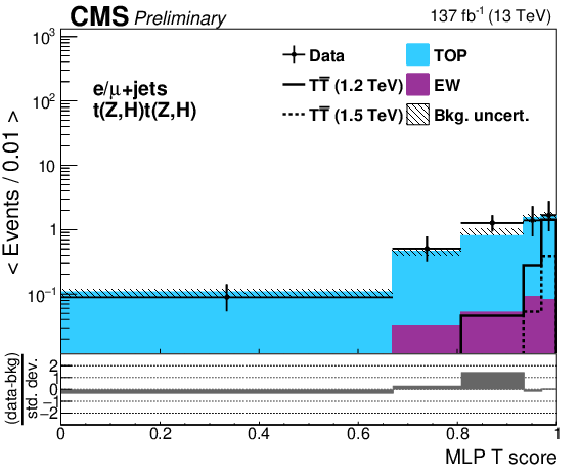
png pdf |
Figure 4-d:
Distributions of the VLQ score in single-lepton categories 1-7 (left-to-right, upper-to-lower). Observed data is shown using black markers, T¯T signal with mass of 1.2 (1.5) TeV in the singlet scenario using solid (dashed) lines, and post-fit background using filled histograms. Statistical and systematic uncertainties in the background prediction after performing the fit to data are shown by the hatched region. Electron and muon categories have been combined with their uncertainties added in quadrature. |
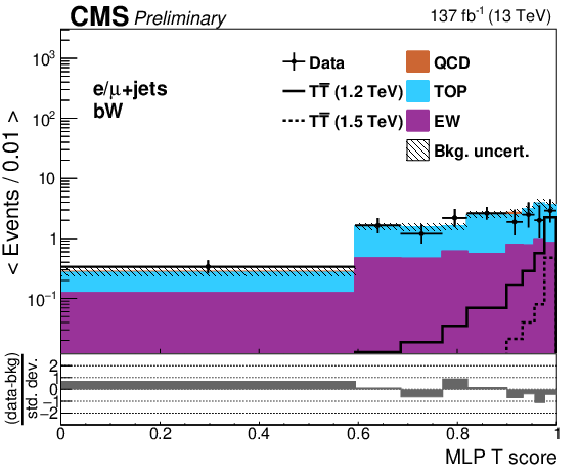
png pdf |
Figure 4-e:
Distributions of the VLQ score in single-lepton categories 1-7 (left-to-right, upper-to-lower). Observed data is shown using black markers, T¯T signal with mass of 1.2 (1.5) TeV in the singlet scenario using solid (dashed) lines, and post-fit background using filled histograms. Statistical and systematic uncertainties in the background prediction after performing the fit to data are shown by the hatched region. Electron and muon categories have been combined with their uncertainties added in quadrature. |
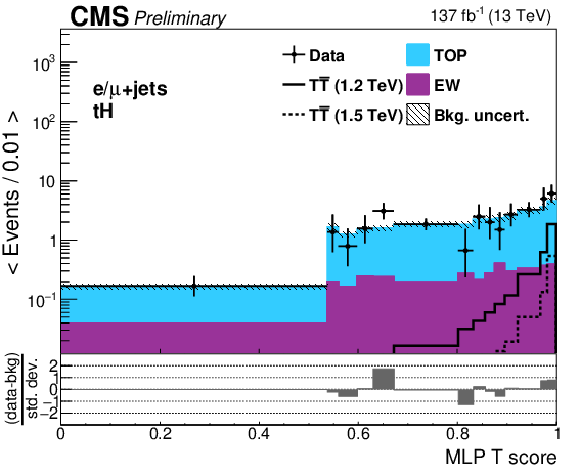
png pdf |
Figure 4-f:
Distributions of the VLQ score in single-lepton categories 1-7 (left-to-right, upper-to-lower). Observed data is shown using black markers, T¯T signal with mass of 1.2 (1.5) TeV in the singlet scenario using solid (dashed) lines, and post-fit background using filled histograms. Statistical and systematic uncertainties in the background prediction after performing the fit to data are shown by the hatched region. Electron and muon categories have been combined with their uncertainties added in quadrature. |
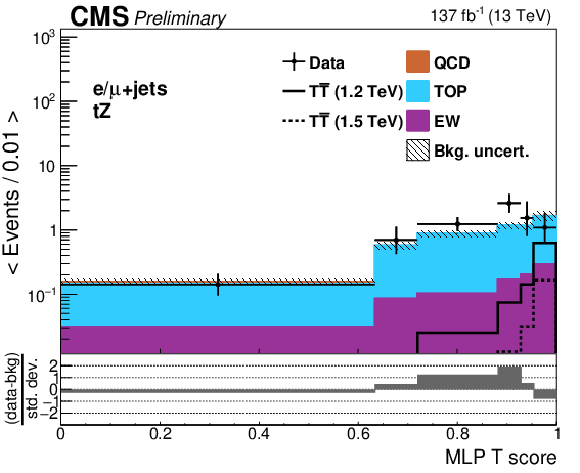
png pdf |
Figure 4-g:
Distributions of the VLQ score in single-lepton categories 1-7 (left-to-right, upper-to-lower). Observed data is shown using black markers, T¯T signal with mass of 1.2 (1.5) TeV in the singlet scenario using solid (dashed) lines, and post-fit background using filled histograms. Statistical and systematic uncertainties in the background prediction after performing the fit to data are shown by the hatched region. Electron and muon categories have been combined with their uncertainties added in quadrature. |
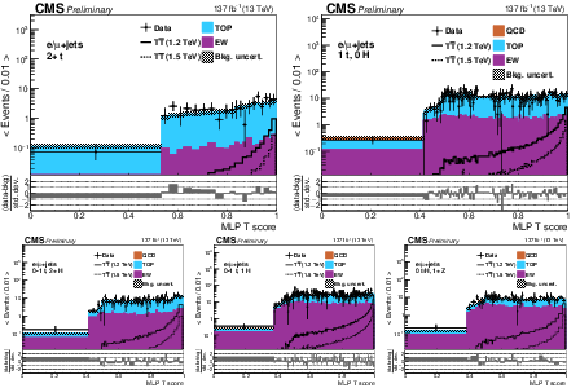
png pdf |
Figure 5:
Distributions of the VLQ score in single-lepton categories 8-12 (left-to-right, upper-to-lower). Observed data is shown using black markers, T¯T signal with mass of 1.2 (1.5) TeV in the singlet scenario using solid (dashed) lines, and post-fit background using filled histograms. Statistical and systematic uncertainties in the background prediction after performing the fit to data are shown by the hatched region. Electron and muon categories have been combined with their uncertainties added in quadrature. |
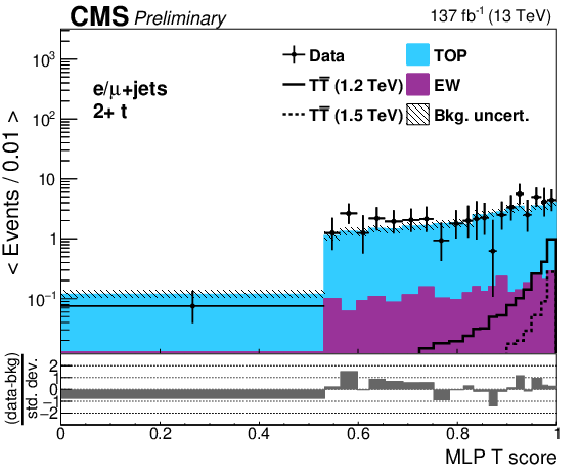
png pdf |
Figure 5-a:
Distributions of the VLQ score in single-lepton categories 8-12 (left-to-right, upper-to-lower). Observed data is shown using black markers, T¯T signal with mass of 1.2 (1.5) TeV in the singlet scenario using solid (dashed) lines, and post-fit background using filled histograms. Statistical and systematic uncertainties in the background prediction after performing the fit to data are shown by the hatched region. Electron and muon categories have been combined with their uncertainties added in quadrature. |
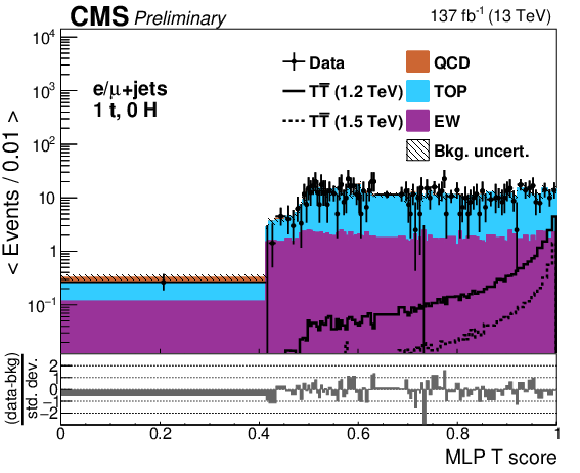
png pdf |
Figure 5-b:
Distributions of the VLQ score in single-lepton categories 8-12 (left-to-right, upper-to-lower). Observed data is shown using black markers, T¯T signal with mass of 1.2 (1.5) TeV in the singlet scenario using solid (dashed) lines, and post-fit background using filled histograms. Statistical and systematic uncertainties in the background prediction after performing the fit to data are shown by the hatched region. Electron and muon categories have been combined with their uncertainties added in quadrature. |
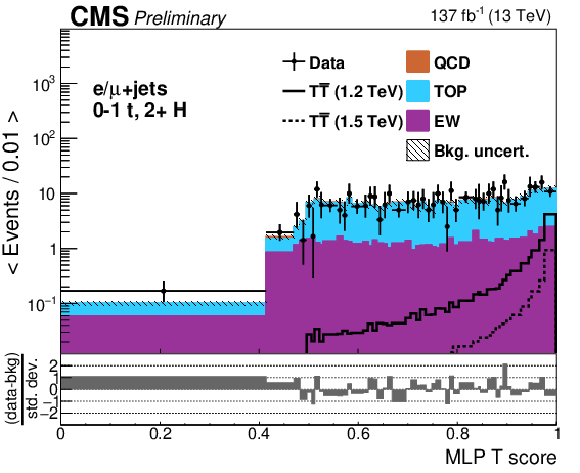
png pdf |
Figure 5-c:
Distributions of the VLQ score in single-lepton categories 8-12 (left-to-right, upper-to-lower). Observed data is shown using black markers, T¯T signal with mass of 1.2 (1.5) TeV in the singlet scenario using solid (dashed) lines, and post-fit background using filled histograms. Statistical and systematic uncertainties in the background prediction after performing the fit to data are shown by the hatched region. Electron and muon categories have been combined with their uncertainties added in quadrature. |
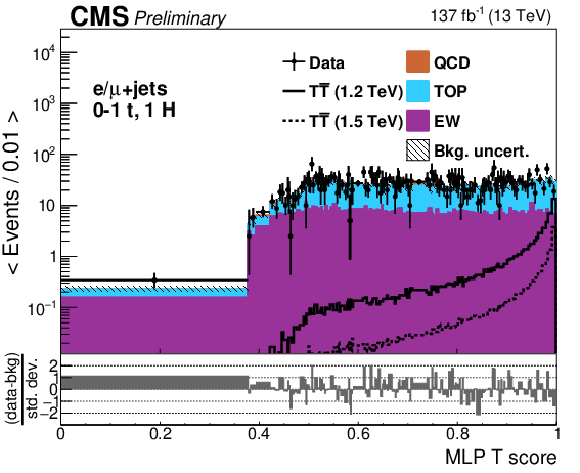
png pdf |
Figure 5-d:
Distributions of the VLQ score in single-lepton categories 8-12 (left-to-right, upper-to-lower). Observed data is shown using black markers, T¯T signal with mass of 1.2 (1.5) TeV in the singlet scenario using solid (dashed) lines, and post-fit background using filled histograms. Statistical and systematic uncertainties in the background prediction after performing the fit to data are shown by the hatched region. Electron and muon categories have been combined with their uncertainties added in quadrature. |
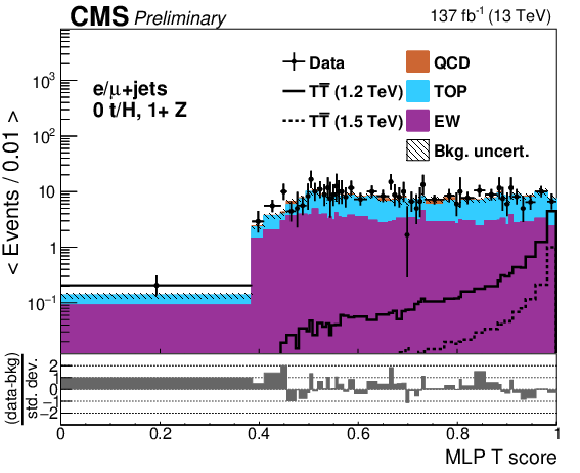
png pdf |
Figure 5-e:
Distributions of the VLQ score in single-lepton categories 8-12 (left-to-right, upper-to-lower). Observed data is shown using black markers, T¯T signal with mass of 1.2 (1.5) TeV in the singlet scenario using solid (dashed) lines, and post-fit background using filled histograms. Statistical and systematic uncertainties in the background prediction after performing the fit to data are shown by the hatched region. Electron and muon categories have been combined with their uncertainties added in quadrature. |

png pdf |
Figure 6:
Distributions of HlepT in the same-sign dilepton signal region for ee, eμ, and μμ categories (left-to-right). Data from 2017 and 2018 is shown using black markers, T¯T signals with mass of 1.2 (1.5) TeV in the singlet scenario using solid (dashed) lines, and post-fit background using filled histograms. Statistical and systematic uncertainties in the background prediction after performing the fit to data are shown by the hatched region. |

png pdf |
Figure 6-a:
Distributions of HlepT in the same-sign dilepton signal region for ee, eμ, and μμ categories (left-to-right). Data from 2017 and 2018 is shown using black markers, T¯T signals with mass of 1.2 (1.5) TeV in the singlet scenario using solid (dashed) lines, and post-fit background using filled histograms. Statistical and systematic uncertainties in the background prediction after performing the fit to data are shown by the hatched region. |

png pdf |
Figure 6-b:
Distributions of HlepT in the same-sign dilepton signal region for ee, eμ, and μμ categories (left-to-right). Data from 2017 and 2018 is shown using black markers, T¯T signals with mass of 1.2 (1.5) TeV in the singlet scenario using solid (dashed) lines, and post-fit background using filled histograms. Statistical and systematic uncertainties in the background prediction after performing the fit to data are shown by the hatched region. |
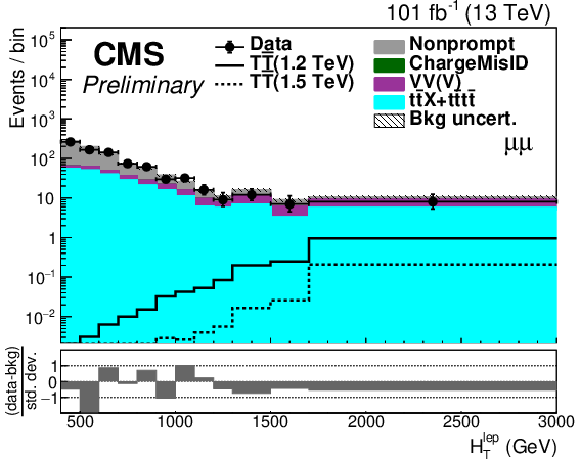
png pdf |
Figure 6-c:
Distributions of HlepT in the same-sign dilepton signal region for ee, eμ, and μμ categories (left-to-right). Data from 2017 and 2018 is shown using black markers, T¯T signals with mass of 1.2 (1.5) TeV in the singlet scenario using solid (dashed) lines, and post-fit background using filled histograms. Statistical and systematic uncertainties in the background prediction after performing the fit to data are shown by the hatched region. |
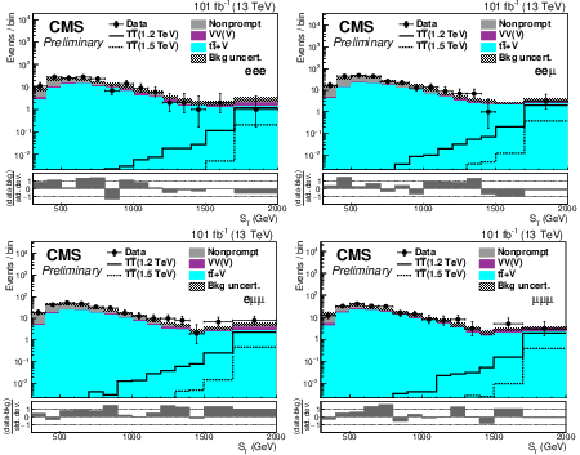
png pdf |
Figure 7:
Distributions of ST in the multilepton signal region for eee, eeμ, eμμ, and μμμ categories (left-to-right, upper-to-lower). Data from 2017 and 2018 is shown using black markers, T¯T signals with mass of 1.2 (1.5) TeV in the singlet scenario using solid (dashed) lines, and post-fit background using filled histograms. Statistical and systematic uncertainties in the background prediction after performing the fit to data are shown by the hatched region. |
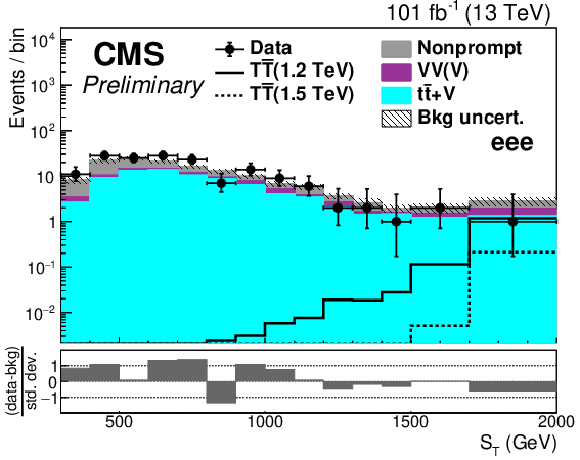
png pdf |
Figure 7-a:
Distributions of ST in the multilepton signal region for eee, eeμ, eμμ, and μμμ categories (left-to-right, upper-to-lower). Data from 2017 and 2018 is shown using black markers, T¯T signals with mass of 1.2 (1.5) TeV in the singlet scenario using solid (dashed) lines, and post-fit background using filled histograms. Statistical and systematic uncertainties in the background prediction after performing the fit to data are shown by the hatched region. |
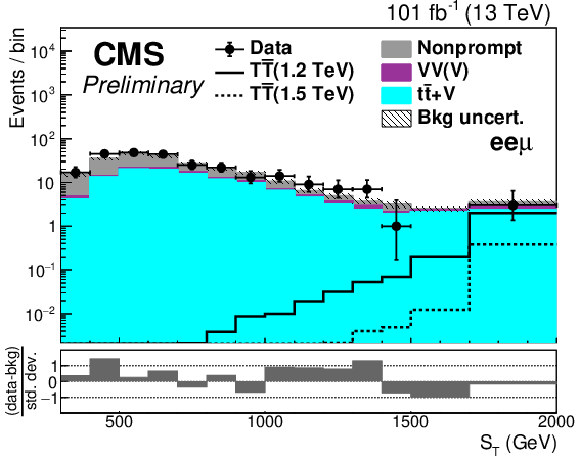
png pdf |
Figure 7-b:
Distributions of ST in the multilepton signal region for eee, eeμ, eμμ, and μμμ categories (left-to-right, upper-to-lower). Data from 2017 and 2018 is shown using black markers, T¯T signals with mass of 1.2 (1.5) TeV in the singlet scenario using solid (dashed) lines, and post-fit background using filled histograms. Statistical and systematic uncertainties in the background prediction after performing the fit to data are shown by the hatched region. |

png pdf |
Figure 7-c:
Distributions of ST in the multilepton signal region for eee, eeμ, eμμ, and μμμ categories (left-to-right, upper-to-lower). Data from 2017 and 2018 is shown using black markers, T¯T signals with mass of 1.2 (1.5) TeV in the singlet scenario using solid (dashed) lines, and post-fit background using filled histograms. Statistical and systematic uncertainties in the background prediction after performing the fit to data are shown by the hatched region. |
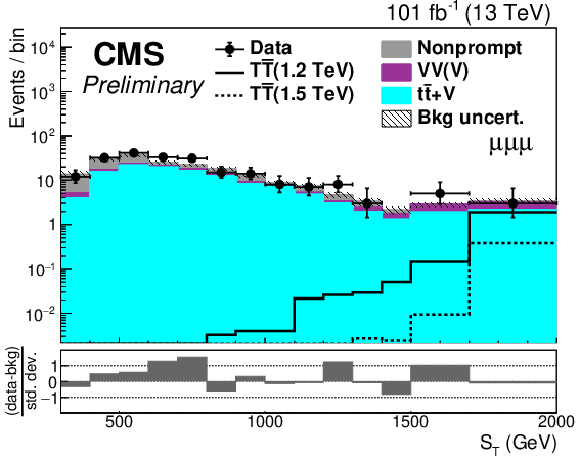
png pdf |
Figure 7-d:
Distributions of ST in the multilepton signal region for eee, eeμ, eμμ, and μμμ categories (left-to-right, upper-to-lower). Data from 2017 and 2018 is shown using black markers, T¯T signals with mass of 1.2 (1.5) TeV in the singlet scenario using solid (dashed) lines, and post-fit background using filled histograms. Statistical and systematic uncertainties in the background prediction after performing the fit to data are shown by the hatched region. |
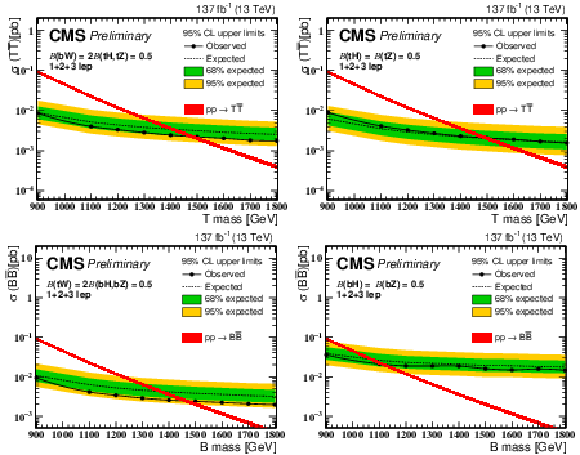
png pdf |
Figure 8:
Expected 95% CL upper limits on T¯T (upper) and B¯B (lower) production cross sections for the singlet (left) and doublet (right) combinations. |
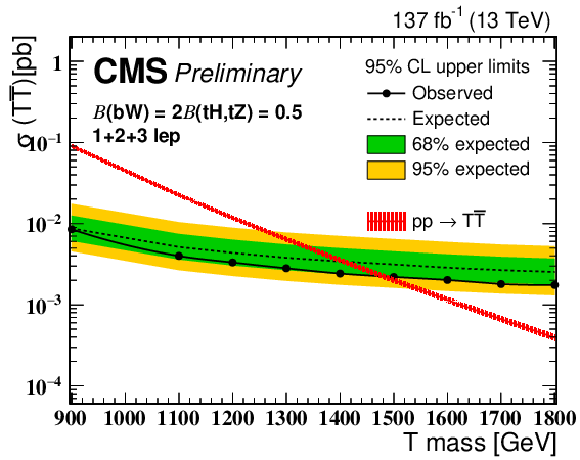
png pdf |
Figure 8-a:
Expected 95% CL upper limits on T¯T (upper) and B¯B (lower) production cross sections for the singlet (left) and doublet (right) combinations. |
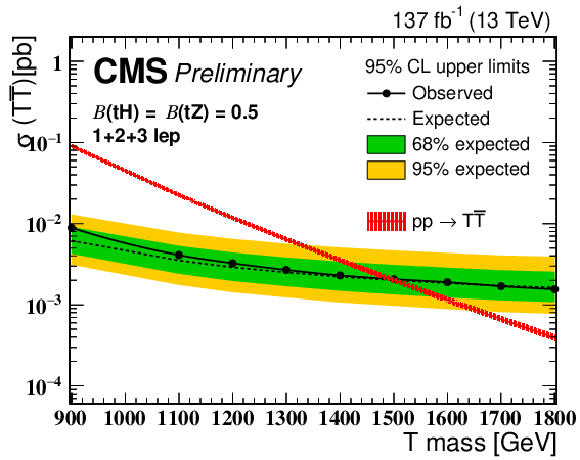
png pdf |
Figure 8-b:
Expected 95% CL upper limits on T¯T (upper) and B¯B (lower) production cross sections for the singlet (left) and doublet (right) combinations. |
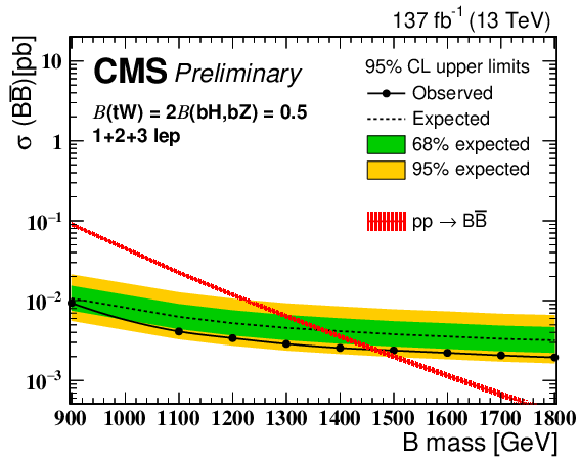
png pdf |
Figure 8-c:
Expected 95% CL upper limits on T¯T (upper) and B¯B (lower) production cross sections for the singlet (left) and doublet (right) combinations. |
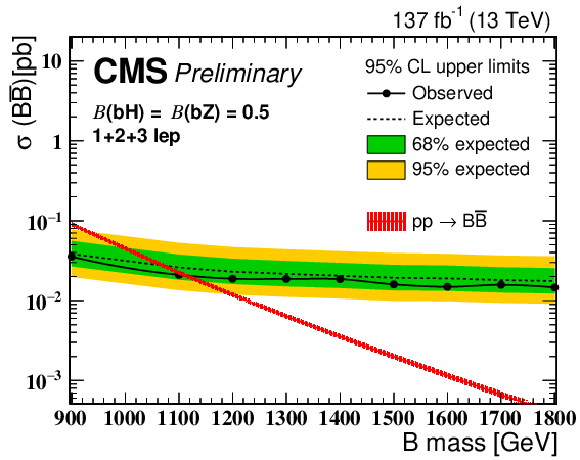
png pdf |
Figure 8-d:
Expected 95% CL upper limits on T¯T (upper) and B¯B (lower) production cross sections for the singlet (left) and doublet (right) combinations. |
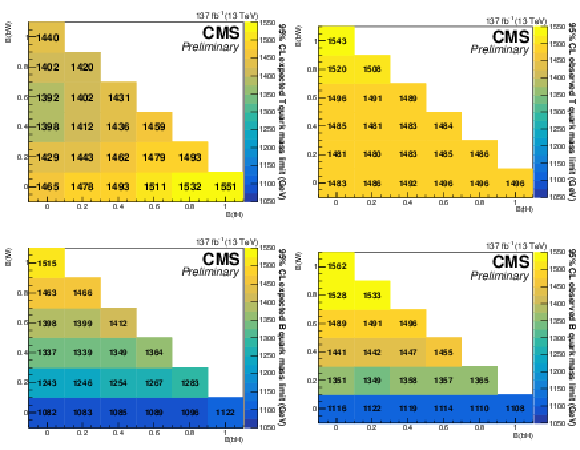
png pdf |
Figure 9:
The 95% CL expected (left) and observed (right) lower limits on pair-produced T (upper) and B (lower) quark masses as a function of the branching ratios to W and H bosons. |
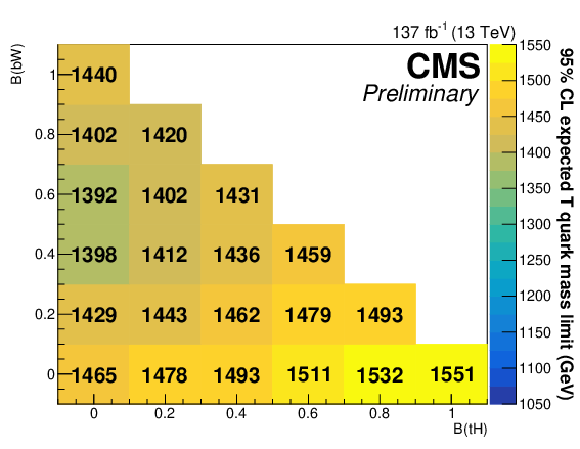
png pdf |
Figure 9-a:
The 95% CL expected (left) and observed (right) lower limits on pair-produced T (upper) and B (lower) quark masses as a function of the branching ratios to W and H bosons. |

png pdf |
Figure 9-b:
The 95% CL expected (left) and observed (right) lower limits on pair-produced T (upper) and B (lower) quark masses as a function of the branching ratios to W and H bosons. |
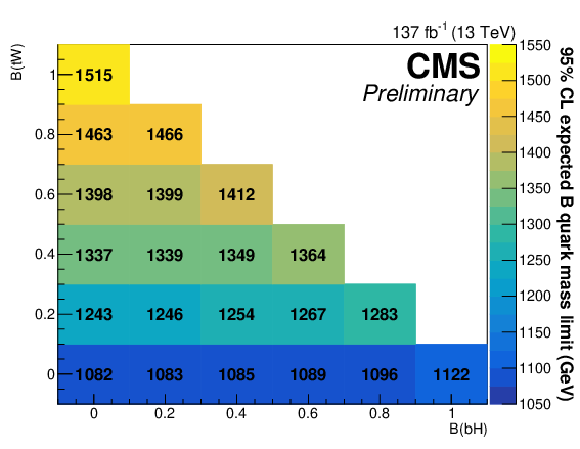
png pdf |
Figure 9-c:
The 95% CL expected (left) and observed (right) lower limits on pair-produced T (upper) and B (lower) quark masses as a function of the branching ratios to W and H bosons. |
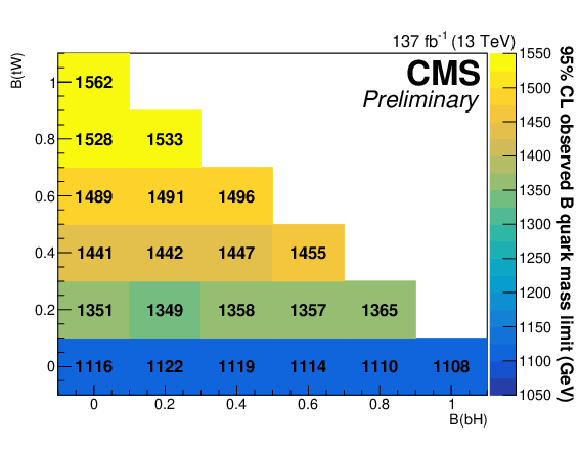
png pdf |
Figure 9-d:
The 95% CL expected (left) and observed (right) lower limits on pair-produced T (upper) and B (lower) quark masses as a function of the branching ratios to W and H bosons. |
| Tables | |
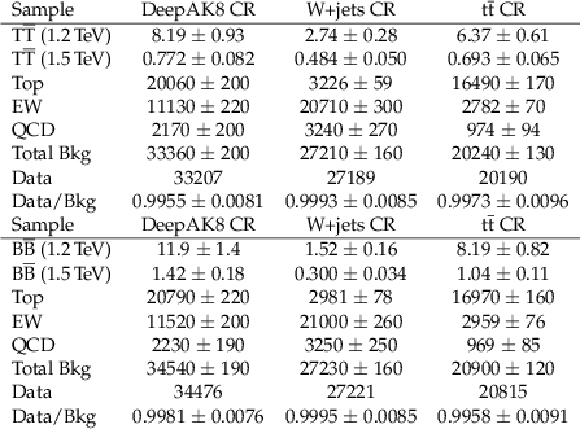
png pdf |
Table 1:
Numbers of predicted and observed CR events in 2016-2018 data for the T¯T and B¯B signal hypotheses in the single-lepton channel, after a background-only fit to data. Predicted numbers of signal events before the fit to data are included for comparison, using the singlet branching fraction scenario. Uncertainties include statistical and systematic components, and lepton flavor categories are combined with their uncertainties added in quadrature. Values in the DeepAK8 CR represent the number of large-radius jets rather than number of events. |
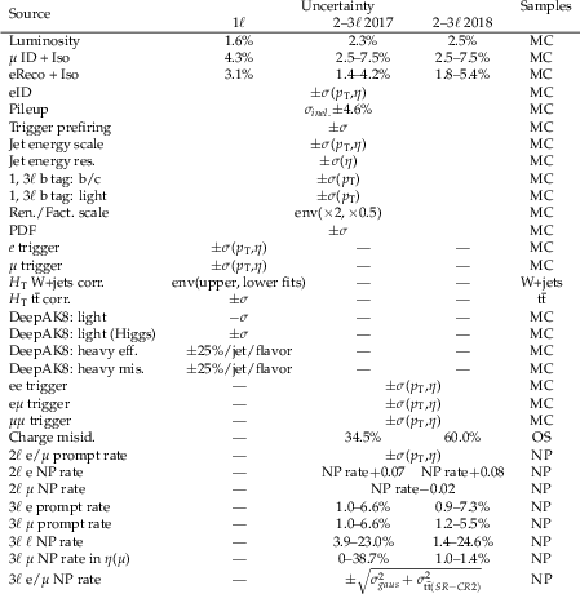
png pdf |
Table 2:
Summary of systematic uncertainty sources for the various analysis channels, grouped according to channel. The second column shows uncertainties for the single-lepton channel, evaluated with 2016-2018 data combined. The third and fourth columns show uncertainties for the other channels, evaluated using 2017 or 2018 data. Ranges indicate representative values across different lepton flavor categories. Uncertainties that affect different sources are indicated as "MC'' for all simulation (including signal), "OS'' for charge misidentification background, and "NP'' for nonprompt lepton background. |

png pdf |
Table 3:
Numbers of predicted and observed T¯T SR events in 2016-2018 data in the single-lepton channel, after a background-only fit to data. Predicted numbers of signal events before the fit to data are included for comparison, using the singlet branching fraction scenario. Uncertainties include statistical and systematic components, and lepton flavor categories are combined with their uncertainties added in quadrature. |
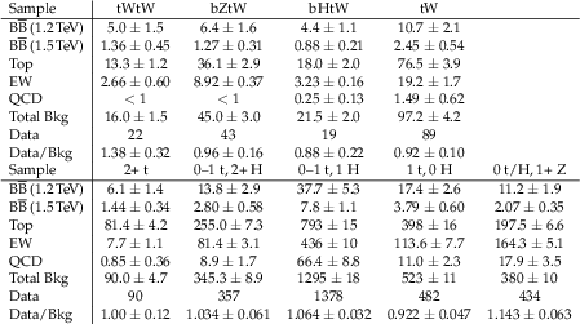
png pdf |
Table 4:
Numbers of predicted and observed B¯B SR events in 2016-2018 data in the single-lepton channel, after a background-only fit to data. Predicted numbers of signal events before the fit to data are included for comparison, using the singlet branching fraction scenario. Uncertainties include statistical and systematic components, and lepton flavor categories are combined with their uncertainties added in quadrature. |
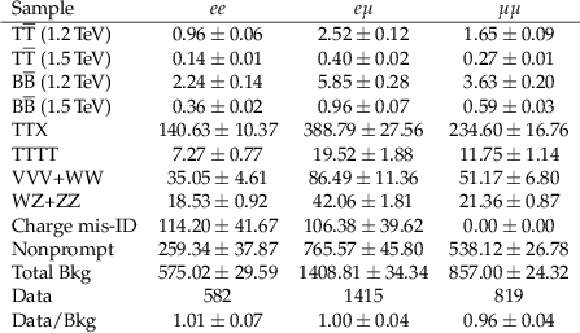
png pdf |
Table 5:
Numbers of predicted and observed SR events in 2017-2018 data in the same-sign dilepton channel, after a background-only fit to data. Predicted numbers of signal events before the fit to data are included for comparison, using the singlet branching fraction scenario. Uncertainties include statistical and systematic components. Predictions for 2017 and 2018 are combined with their uncertainties added in quadrature. |
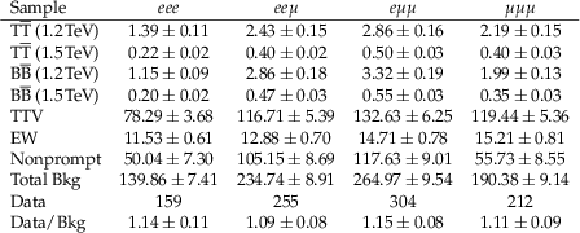
png pdf |
Table 6:
Numbers of predicted and observed SR events in 2017-2018 data in the multilepton channel, after a background-only fit to data. Predicted numbers of signal events before the fit to data are included for comparison, using the singlet branching fraction scenario. Uncertainties include statistical and systematic components. Predictions for 2017 and 2018 are combined with their uncertainties added in quadrature. |
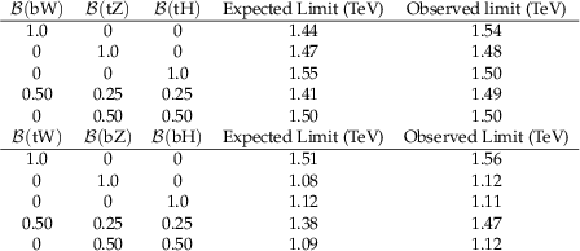
png pdf |
Table 7:
Expected and observed lower limits on the T and B quark masses. |
| Summary |
| We have presented a search for vector-like T and B quark-antiquark pairs produced in proton-proton collisions at a center-of-mass energy of 13 TeV. Data collected by the CMS Experiment at the LHC in 2016-2018 have been analyzed in single-lepton, same-sign dilepton, and multilepton final states. In the single-lepton channel, parent particles of large-radius jets were identified using the DeepAK8 algorithm, and vector-like quark candidates were reconstructed by forming quark-boson pairs consistent with a T or B decay. To account for events without consistent vector-like quark decays, a multilayer perceptron network was trained to separate signal events from standard model backgrounds. In the same-sign dilepton and multilepton channels, low background rates and the large energy signature of the signal were exploited by studying jet and lepton momentum sum distributions. We exclude pair production for T quarks with masses up to 1.54 TeV and for B quarks with masses up to 1.56 TeV, depending on the branching fraction scenario. These are the strongest limits to date on T¯T production with tH and bW decay modes and on B quark production where the B quark has a significant branching fraction to tW. |
| References | ||||
| 1 | ATLAS Collaboration | Observation of a new particle in the search for the Standard Model Higgs boson with the ATLAS detector at the LHC | PLB 716 (2012) 1 | 1207.7214 |
| 2 | CMS Collaboration | Observation of a new boson at a mass of 125 GeV with the CMS experiment at the LHC | PLB 716 (2012) 30 | CMS-HIG-12-028 1207.7235 |
| 3 | CMS Collaboration | Observation of a new boson with mass near 125 GeV in pp collisions at √s= 7 and 8 TeV | JHEP 06 (2013) 081 | CMS-HIG-12-036 1303.4571 |
| 4 | M. Perelstein, M. E. Peskin, and A. Pierce | Top quarks and electroweak symmetry breaking in little Higgs models | PRD 69 (2004) 075002 | hep-ph/0310039 |
| 5 | O. Matsedonskyi, G. Panico, and A. Wulzer | Light top partners for a light composite Higgs | JHEP 01 (2013) 164 | 1204.6333 |
| 6 | R. Contino, L. Da Rold, and A. Pomarol | Light custodians in natural composite Higgs models | PRD 75 (2007) 055014 | hep-ph/0612048 |
| 7 | R. Contino, T. Kramer, M. Son, and R. Sundrum | Warped/composite phenomenology simplified | JHEP 05 (2007) 074 | hep-ph/0612180 |
| 8 | J. A. Aguilar-Saavedra, R. Benbrik, S. Heinemeyer, and M. Pérez-Victoria | Handbook of vectorlike quarks: Mixing and single production | PRD 88 (2013), no. 9, 094010 | 1306.0572 |
| 9 | A. De Simone, O. Matsedonskyi, R. Rattazzi, and A. Wulzer | A First Top Partner Hunter's Guide | JHEP 04 (2013) 004 | 1211.5663 [hep-ph] |
| 10 | F. del Aguila, L. Ametller, G. L. Kane, and J. Vidal | Vector-like fermion and standard Higgs production at hadron colliders | NPB 334 (1990) 1 | |
| 11 | CMS Collaboration | Search for a vector-like quark with charge 2/3 in t + Z events from pp collisions at √s= 7 TeV | PRL 107 (2011) 271802 | CMS-EXO-11-005 1109.4985 |
| 12 | CMS Collaboration | Search for pair produced fourth-generation up-type quarks in pp collisions at √s= 7 TeV with a lepton in the final state | PLB 718 (2012) 307 | CMS-EXO-11-099 1209.0471 |
| 13 | ATLAS Collaboration | Search for pair production of a new quark that decays to a Z boson and a bottom quark with the ATLAS detector | PRL 109 (2012) 071801 | 1204.1265 |
| 14 | CMS Collaboration | Search for vector-like charge 2/3 T quarks in proton-proton collisions at √s= 8 TeV | PRD 92 (2016) 012003 | CMS-B2G-13-005 1509.04177 |
| 15 | CMS Collaboration | Inclusive search for a vector-like T quark with charge 2/3 in pp collisions at √s= 8 TeV | PLB 729 (2014) 149 | CMS-B2G-12-015 1311.7667 |
| 16 | ATLAS Collaboration | Search for pair production of a new heavy quark that decays into a W boson and a light quark in pp collisions at √s= 8 TeV with the ATLAS detector | PRD 92 (2015) 112007 | 1509.04261 |
| 17 | ATLAS Collaboration | Search for production of vector-like quark pairs and of four top quarks in the lepton-plus-jets final state in pp collisions at √s= 8 TeV with the ATLAS detector | JHEP 08 (2015) 105 | 1505.04306 |
| 18 | CMS Collaboration | Search for pair production of vector-like quarks in the bWbW channel from proton-proton collisions at √s= 13 TeV | PLB 779 (2018) 82 | CMS-B2G-17-003 1710.01539 |
| 19 | CMS Collaboration | Search for vector-like T and B quark pairs in final states with leptons at √s= 13 TeV | JHEP 08 (2018) 177 | CMS-B2G-17-011 1805.04758 |
| 20 | CMS Collaboration | Search for vector-like quarks in events with two oppositely charged leptons and jets in proton-proton collisions at √s= 13 TeV | EPJC 79 (2019), no. 4, 364 | CMS-B2G-17-012 1812.09768 |
| 21 | CMS Collaboration | Search for pair production of vectorlike quarks in the fully hadronic final state | PRD 100 (2019), no. 7, 072001 | CMS-B2G-18-005 1906.11903 |
| 22 | CMS Collaboration | A search for bottom-type, vector-like quark pair production in a fully hadronic final state in proton-proton collisions at √s= 13 TeV | PRD 102 (2020) 112004 | CMS-B2G-19-005 2008.09835 |
| 23 | ATLAS Collaboration | Combination of the searches for pair-produced vector-like partners of the third-generation quarks at √s= 13 TeV with the ATLAS detector | PRL 121 (2018), no. 21, 211801 | 1808.02343 |
| 24 | ATLAS Collaboration | Search for pair-production of vector-like quarks in pp collision events at √s= 13 TeV with at least one leptonically-decaying Z boson and a third-generation quark with the ATLAS detector | ATLAS-CONF-2021-024 | |
| 25 | CMS Collaboration | The CMS Experiment at the CERN LHC | JINST 3 (2008) S08004 | CMS-00-001 |
| 26 | CMS Collaboration | Particle-flow reconstruction and global event description with the CMS detector | JINST 12 (2017) P10003 | CMS-PRF-14-001 1706.04965 |
| 27 | M. Cacciari, G. P. Salam, and G. Soyez | The anti-kT jet clustering algorithm | JHEP 04 (2008) 063 | 0802.1189 |
| 28 | M. Cacciari, G. P. Salam, and G. Soyez | FastJet user manual | EPJC 72 (2012) 1896 | 1111.6097 |
| 29 | CMS Collaboration | Pileup mitigation at CMS in 13 TeV data | JINST 15 (2020) P09018 | CMS-JME-18-001 2003.00503 |
| 30 | D. Bertolini, P. Harris, M. Low, and N. Tran | Pileup Per Particle Identification | JHEP 10 (2014) 059 | 1407.6013 |
| 31 | CMS Collaboration | Jet energy scale and resolution in the CMS experiment in pp collisions at 8 TeV | JINST 12 (2017) P02014 | CMS-JME-13-004 1607.03663 |
| 32 | CMS Collaboration | Performance of missing transverse momentum reconstruction in proton-proton collisions at √s= 13 TeV using the CMS detector | JINST 14 (2019) P07004 | CMS-JME-17-001 1903.06078 |
| 33 | CMS Collaboration | Performance of the CMS Level-1 trigger in proton-proton collisions at √s= 13 TeV | JINST 15 (2020) P10017 | CMS-TRG-17-001 2006.10165 |
| 34 | CMS Collaboration | The CMS trigger system | JINST 12 (2017) P01020 | CMS-TRG-12-001 1609.02366 |
| 35 | NNPDF Collaboration | Parton distributions for the LHC Run II | JHEP 04 (2015) 040 | 1410.8849 |
| 36 | NNPDF Collaboration | Parton distributions from high-precision collider data | EPJC 77 (2017) 663. 95 p | 1706.00428 |
| 37 | J. Butterworth et al. | Pdf4lhc recommendations for lhc run ii | JPG: Nucl. Part. Phys. 43 (2016) 023001 | 1510.03865 |
| 38 | P. Nason | A new method for combining NLO QCD with shower Monte Carlo algorithms | JHEP 11 (2004) 040 | hep-ph/0409146 |
| 39 | S. Frixione, P. Nason, and C. Oleari | Matching NLO QCD computations with parton shower simulations: the POWHEG method | JHEP 11 (2007) 070 | 0709.2092 |
| 40 | S. Alioli, P. Nason, C. Oleari, and E. Re | A general framework for implementing NLO calculations in shower Monte Carlo programs: the POWHEG BOX | JHEP 06 (2010) 043 | 1002.2581 |
| 41 | S. Frixione, P. Nason, and G. Ridolfi | A positive-weight next-to-leading-order Monte Carlo for heavy flavour hadroproduction | JHEP 09 (2007) 126 | 0707.3088 |
| 42 | S. Alioli, P. Nason, C. Oleari, and E. Re | NLO single-top production matched with shower in POWHEG: s- and t-channel contributions | JHEP 09 (2009) 111 | 0907.4076 |
| 43 | E. Re | Single-top Wt-channel production matched with parton showers using the POWHEG method | EPJC 71 (2011) 1547 | 1009.2450 |
| 44 | T. Melia, P. Nason, R. Rontsch, and G. Zanderighi | W+W-, WZ and ZZ production in the POWHEG BOX | JHEP 11 (2011) 078 | 1107.5051 |
| 45 | P. Nason and G. Zanderighi | W+W− , WZ and ZZ production in the POWHEG-BOX-V2 | EPJC 74 (2014), no. 1 | 1311.1365 |
| 46 | P. Artoisenet, R. Frederix, O. Mattelaer, and R. Rietkerk | Automatic spin-entangled decays of heavy resonances in Monte Carlo simulations | JHEP 03 (2013) 015 | 1212.3460 |
| 47 | J. Alwall et al. | The automated computation of tree-level and next-to-leading order differential cross sections, and their matching to parton shower simulations | JHEP 07 (2014) 079 | 1405.0301 |
| 48 | J. Alwall et al. | Comparative study of various algorithms for the merging of parton showers and matrix elements in hadronic collisions | EPJC 53 (2008) 473 | 0706.2569 |
| 49 | R. Frederix and S. Frixione | Merging meets matching in MC@NLO | JHEP 12 (2012) 061 | 1209.6215 |
| 50 | T. Sjostrand et al. | An introduction to PYTHIA 8.2 | CPC 191 (2015) 159 | 1410.3012 |
| 51 | GEANT4 Collaboration | GEANT4---a simulation toolkit | NIMA 506 (2003) 250 | https://doi.org/10.1016/S0168-9002(03)01368-8 |
| 52 | CMS Collaboration | Technical proposal for the Phase-II upgrade of the Compact Muon Solenoid | CMS-PAS-TDR-15-002 | CMS-PAS-TDR-15-002 |
| 53 | CMS Collaboration | Performance of electron reconstruction and selection with the CMS detector in proton-proton collisions at √s= 8 TeV | JINST 10 (2015) P06005 | CMS-EGM-13-001 1502.02701 |
| 54 | CMS Collaboration | Performance of the CMS muon detector and muon reconstruction with proton-proton collisions at √s= 13 TeV | JINST 13 (2018), no. 06, P06015 | CMS-MUO-16-001 1804.04528 |
| 55 | M. Cacciari, G. P. Salam, and G. Soyez | The catchment area of jets | JHEP 04 (2008) 005 | 0802.1188 |
| 56 | E. Bols et al. | Jet Flavour Classification Using DeepJet | JINST 15 (2020), no. 12, P12012 | 2008.10519 |
| 57 | CMS Collaboration | Performance of the DeepJet b tagging algorithm using 41.9/fb of data from proton-proton collisions at 13 TeV with Phase 1 CMS detector | CDS | |
| 58 | CMS Collaboration | Identification of heavy, energetic, hadronically decaying particles using machine-learning techniques | JINST 15 (2020), no. 06, P06005 | CMS-JME-18-002 2004.08262 |
| 59 | J. Thaler and K. Van Tilburg | Identifying boosted objects with N-subjettiness | JHEP 03 (2011) 015 | 1011.2268 |
| 60 | M. Dasgupta, A. Fregoso, S. Marzani, and G. P. Salam | Towards an understanding of jet substructure | JHEP 09 (2013) 029 | 1307.0007 |
| 61 | J. M. Butterworth, A. R. Davison, M. Rubin, and G. P. Salam | Jet substructure as a new Higgs search channel at the LHC | PRL 100 (2008) 242001 | 0802.2470 |
| 62 | A. J. Larkoski, S. Marzani, G. Soyez, and J. Thaler | Soft Drop | JHEP 05 (2014) 146 | 1402.2657 |
| 63 | F. Pedregosa et al. | Scikit-learn: Machine learning in Python | Journal of Machine Learning Research 12 (2011) 2825 | 1201.0490 |
| 64 | D. P. Kingma and J. Ba | Adam: A method for stochastic optimization | 2017 \url https://arxiv.org/abs/1412.6980 | |
| 65 | CMS Collaboration | Search for new physics with same-sign isolated dilepton events with jets and missing transverse energy | PRL 109 (2012) 071803 | CMS-SUS-11-010 1205.6615 |
| 66 | CMS Collaboration | Measurement of the inelastic proton-proton cross section at √s= 13 TeV | Submitted to \it JHEP | CMS-FSQ-15-005 1802.02613 |
| 67 | W. S. Cleveland | Robust locally weighted regression and smoothing scatterplots | Journal of the American Statistical Association 74 (1979) | |
| 68 | W. S. Cleveland and S. J. Devlin | Locally weighted regression: An approach to regression analysis by local fitting | Journal of the American Statistical Association 83 (1988) | |
| 69 | R. Barlow and C. Beeston | Fitting using finite Monte Carlo samples | CPC (1993) 219 | |
| 70 | J. S. Conway | Incorporating Nuisance Parameters in Likelihoods for Multisource Spectra | in PHYSTAT 2011, p. 115 2011 | 1103.0354 |
| 71 | G. Cowan, K. Cranmer, E. Gross, and O. Vitells | Asymptotic formulae for likelihood-based tests of new physics | EPJC 71 (2011) 1554 | 1007.1727 |

|
Compact Muon Solenoid LHC, CERN |

|

|

|

|

|

|